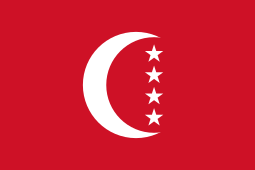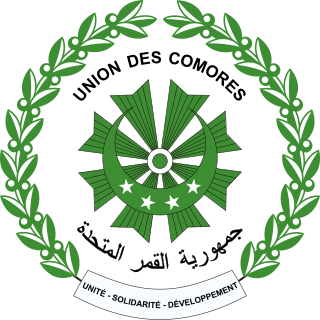
The Politics of the Union of the Comoros take place in a framework of a unitary presidential republic, whereby the President of the Comoros is both head of state and head of government, and of a multi-party system. Executive power is exercised by the government. Legislative power is vested in both the government and parliament. The precolonial legacies of the sultanates linger while the political situation in Comoros has been extremely fluid since the country's independence in 1975, subject to the volatility of coups and political insurrection.

Mayotte, officially the Department of Mayotte, is an overseas department and region and single territorial collectivity of France. It is located in the northern part of the Mozambique Channel in the Indian Ocean off the coast of Southeastern Africa, between Northwestern Madagascar and Northeastern Mozambique. Mayotte consists of a main island, Grande-Terre, a smaller island, Petite-Terre, as well as several islets around these two. Mayotte is the most prosperous territory in the Mozambique Channel, making it a major destination for immigration.

Anjouan is an autonomous volcanic island in the Comoro Islands in the southwestern Indian Ocean, part of the Union of the Comoros. It is known in Shikomori as Ndzuani, Ndzuwani or Nzwani, and, until the early twentieth century when the name fell out of general use, in English as Johanna. Historically it was also called Hinzuan or Hanzoan.
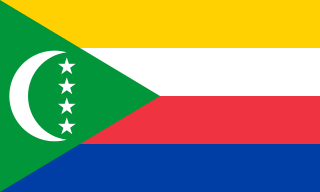
The national flag of the Union of the Comoros was designed in 2001 and officially adopted on 23 December of that year. It continues to display the crescent and four stars, which is a motif that has been in use in various forms since 1975 during the independence movement. In its constitution, the government of the Comoros refers to the insignia as l'emblème national, or the "national emblem", though it is understood to actually represent a flag.

The Comoro Islands or the Comoros are an archipelago of volcanic islands situated off the southeastern coast of Africa, to the east of Mozambique and northwest of Madagascar. The islands are politically divided between the Union of the Comoros, a sovereign country, and Mayotte, an Overseas Department of France.
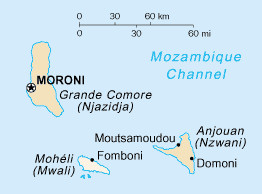
Mohéli, also known as Mwali, is an autonomously-governed island that forms part of the Union of the Comoros. It is the smallest of the three major islands in the country. It is located in the Indian Ocean off the coast of Africa and it is the smallest of the four major Comoro Islands. Its capital and largest city is Fomboni.
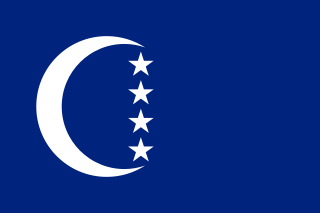
Grande Comore is an island in Comoros off the coast of Africa. It is the largest island in the Comoros nation. Most of its population is of the Comorian ethnic group. Its population as of 2006 is about 316,600. The island's capital is Moroni, which is also the national capital. The island is made up of two shield volcanoes, with Mount Karthala being the country's highest point at 2,361 m (7,746 ft) above sea level. According to the 2009 revision of the constitution of 2002, it is governed by an elected Governor, as are the other islands, with the federal government being much reduced in power. The name Ngazidja is sometimes seen in the now nonstandard form Njazidja.

Mutsamudu is the second-largest city in the Comoros. It is also the capital and largest city on the island of Anjouan as well the former home of former Comorian president Ahmed Abdallah Mohamed Sambi. It now houses a deep water port, an ancient citadel, and narrow streets with many shops and small crafts. The population in 2021 stood at 23,594.
Domoni is the second largest city on the Comorian island of Anjouan in the Indian Ocean and is located on the east coast of the island. It was the capital of the island in the past while the present capital of Anjouan is Mutsamudu.
The following is a list of the political history of East Africa.

In 1892 the French omnibus Navigation and Commerce issue of postage stamps included types specifically intended for use in the island of Anjouan. These were inscribed "SULTANAT / D'ANJOUAN". A series of surcharged values issued in 1912 was available for use in Madagascar and all of the Comoros, and thereafter stamps of Madagascar were used. In 1950, Anjouan used the stamps of the Comoros.

Frances's sparrowhawk is a small bird of prey. This species was formerly placed in the genus Accipiter. The nominate subspecies, T. f. francesiae, is endemic to Madagascar, and the other subspecies are found in the Comoro Islands. The Anjouan sparrowhawk, also known as the Anjouan Island sparrowhawk, Ndzuwani goshawk or Joanna Island goshawk, was thought to be extinct until searches in the 1980s and in 2005 confirmed that it is still extant.
The postage stamps and postal history of the Comoro Islands is an overview of the postage stamps and postal history of the Comoro Islands, an Indian Ocean archipelago located on the south-east side of Africa.
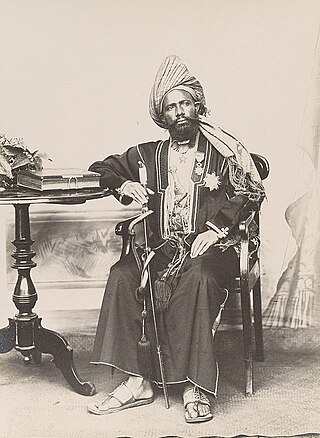
Said Ali bin Said Omar was the Sultan of Grande Comore. He was the first and last sultan tibe or paramount king of the whole island of Ngazidja.
Steal Nouvel FC de Sima is a football (soccer) club from the Comoros based in Sima.
Halima IV, also called Alimah IV, was the sovereign Sultana regnant of the Anjouan sultanate at Nzwani in the Comoro Islands from 1788 until 1792.

Comorian nationality law is regulated by the Constitution of the Comoros, as amended; the Comorian Nationality Code, and its revisions; and various international agreements to which the country is a signatory. These laws determine who is, or is eligible to be, a national of the Comoros. The legal means to acquire nationality, formal legal membership in a nation, differ from the domestic relationship of rights and obligations between a national and the nation, known as citizenship. Comorian nationality is typically obtained under the principle of jus soli, i.e. by birth in the Comoros, or jus sanguinis, born abroad to parents with Comorian nationality. It can be granted to persons with an affiliation to the country, or to a permanent resident who has lived in the country for a given period of time through naturalization. The country no longer allows for nationality to be acquired through investment.

The flag of Grande Comore was adopted in 2002. It is a navy blue field with a white crescent moon and four white stars in the hoist side.
